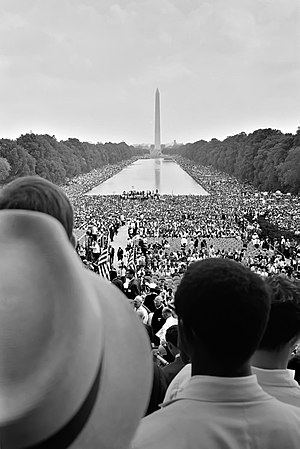
Crowds surrounding the Reflecting Pool, during the 1963 March on Washington. (Photo credit: Wikipedia)
By Brittney Cooper
I must say, the 50th anniversary of the March on Washington for Jobs, Justice, and Freedom left me feeling mostly uninspired. Though there was some attempt in the early portion of the program to include younger speakers, the main portion of the event featured activists, politicians and figureheads all over the age of 40. The representation of women was yet again minimal as was true in the first march. And while the Rev. Sharpton gave a rousing sermon, it felt more like a eulogy for a bygone era, than a call to action.
Saturday’s march attempted to recapture the spirit and legacy of black politics 50 years ago, to “get that old thing back.” Certainly, many of the issues remain similar. As Dave Zirin noted in the Nation, the D.C. police confiscated the signs of marchers that had the phrase “The New Jim Crow” stamped on them. Al Sharpton railed against the kind of right-wing chicanery that has gutted the Voting Rights Act.
Signs with pictures of Trayvon Martin’s face were plastered throughout the crowd, and his mother addressed the audience. The fact that the issues are still very similar 50 years later – black boys shot down with impunity, rampant black joblessness, the vote unprotected, and women’s issues largely invisible – means that the long black freedom struggle continues. But the old ways of struggling are summarily dead.
There are three major characteristics that distinguished this march from its predecessor.
First, MOW ’63 captured the hearts and minds of the nation with such power because it capitalized on what was considered new media back then: personal televisions. People were struck by the image of seeing gratuitous kinds of violence being done to peaceful black people sprayed by fire hoses and attacked by dogs; Americans were awed by the sheer numbers of people who showed up on the National Mall.
MOW ’63 was a media spectacle as much as it was anything else. But visual culture has greatly shifted in the 50 years since then. People under 35 watch far less television than those over 35 do. The limited coverage of the event, mostly on cable news stations, attests to the utter lack of interest of broad swaths of the American public and most assuredly to the declining dominance of television. The last time a black march arrested America’s attention in that way was the Million Man March in 1995. Two decades later, it is safe to say that national pilgrimages to Washington hold far more symbolic than political capital.
Read More Marches won’t cut it anymore: Why last weekend felt like a funeral – Salon.com.
Filed under: News from the Soul Brother